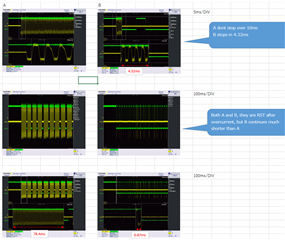Hi team,
My customer have found different overcurrent behavior in different chip. Please see below waveforms to give me your thoughts about why there is difference.
And could you please teach me the detailed behavior of overcurrent.
Customer also want to know why Schottky diode is required when Rocp = 22kohm, which is written in Ioc of E.C.. What will happen without the Schottky?
Situation: PVDD = 24V, PBTL, Rocp = 30kohm (14A)
When overcurrent occurs, host sends RST to restart.
Waveforms - CH1(yellow): Output current, CH2(Green): SD

Best regards,
Hayashi

